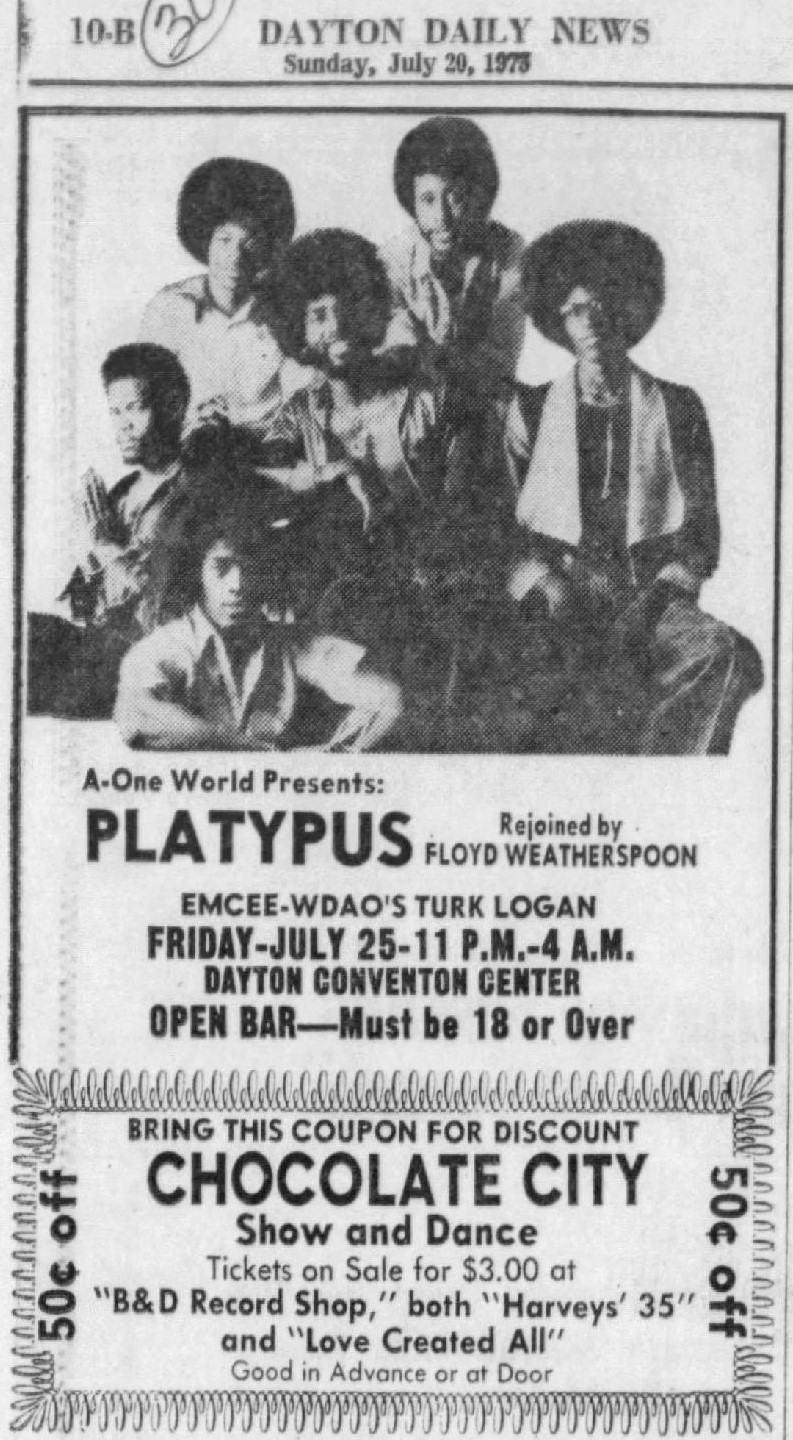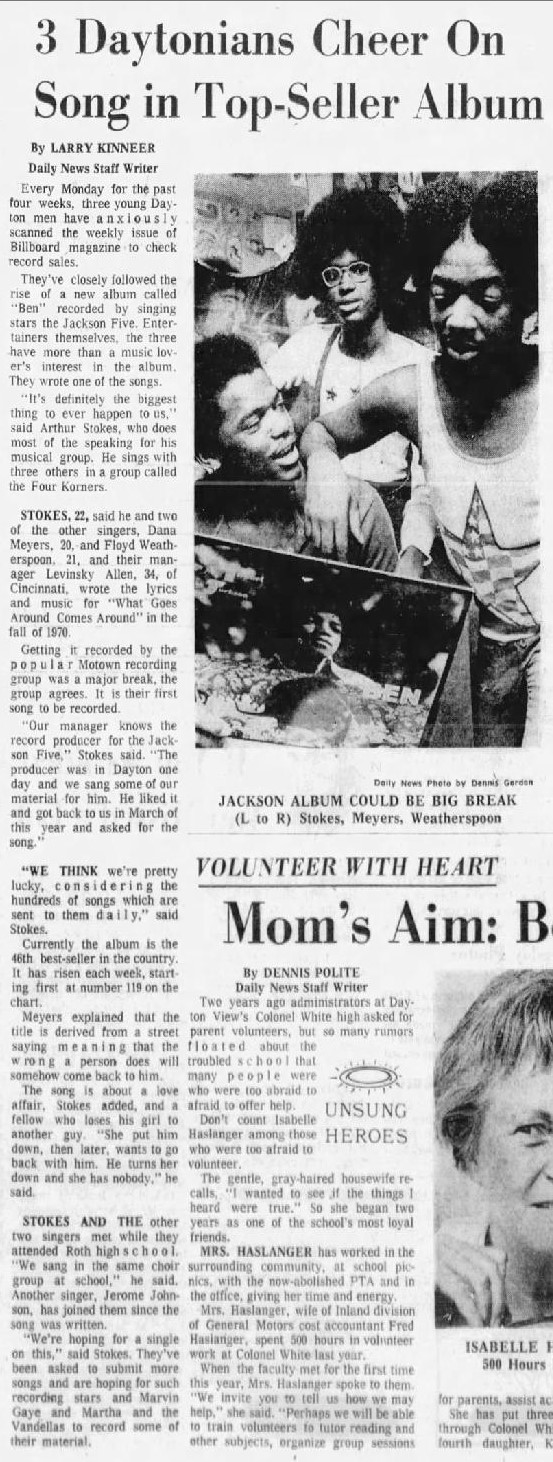Platypus / Four Corners / Four Korners
Dayton, 1968-80

The many bands that came from Dayton's funk explosion of the 1970s all have unique stories. Platypus spent nearly 6 years developing their sound, even touring Australia and Japan, before releasing their first LP.
The story begins at Roth HS in Dayton, where in 1968 three students, all in the school choir, formed a vocal group. The original members were Floyd Weatherspoon, Arthur Stokes (the leader), and Dana Meyers. Later Jerome Johnson became the fourth member. The group peformed locally, using the Fabulous Originals as a backing band.
In 1969 they recorded their only 45 as the Four Corners at Jewel. "Mad About The Girl", credited to Floyd, is an excellent hearfelt ballad, and sold a decent number of copies.

The group continued on for a couple more years, until they caught a break. The group was managed by Levitsky Allen from Cincinnati. Allen was friends with Hal Davis, who had produced the Jackson Five. Allen, along with Stokes, Meyers, and Weatherspoon, wrote the song "What Goes Around, Comes Around" and Davis got Michael Jackson to record it on his solo LP "Ben". Although the song was not on a 45, the LP reached the top 10 LP charts, and the band got a decent amount of money.
Around the time the "Ben" LP was climbing the charts, the group - using the spelling Four Korners - evolved into a self contained vocal group and band. Another Dayton band, the Bad Bunch, suffered a terrible tragedy when a band truck crashed on the way home from a gig, killing one member and leaving another a paraplegic. Two surviving members of the Bad Bunch, Kerry Rutledge (guitar) and Curtis Sanford (drums), joined the Four Korners, and along with the four singers, Larry Hines (lead guitar) and Lloyd Jones (bass), they now had a formidable group.
Taking the royalty money, they all headed west, to end up in Los Angeles, except for Jerome Johnson. Jerome was married and had a baby and didn't want to uproot his family. After a stop in Kansas City, the group set up in LA and thanks to the Motown connection - corresponding with the label's move to LA - were able to get introductions and gigs. They met, and were managed, by Sandy Newman and Beverly Smolen. The group played locally for awhile and set themselves apart by playing covers of progressive rock songs such as "Roundabout" by Yes, a song that stayed in their show for years. They consciously incorporated the rock influences (Yes and Genesis, for two), which was one of the reasons they adopted a new name, Platypus. The Platypus seems to have parts from several different types of animals, which represented how the band felt they were made from the different parts of funk, vocal groups, and rock.
After a year or so in Los Angeles, Floyd Weatherspoon moved back to Dayton, so the group was at 6 members. In 1975 through 1976 they made the tours through Australia and Japan. While in Japan they met Roberta Flack, who really liked them and encouraged them to return home and start working on recording and getting a record deal. They went back to Dayton, then to NYC where they started working on the recordings. Back in Ohio, they worked on a full LP at Cincinnati's Fifth Floor studio. Eventually the band signed with Casablanca, the home of Kiss, the Village People, and Donna Summer. While they were reluctant to give up the prog elements that had impressed their fans, they decided to record some disco ready songs such as "Dancing in the Moonlight" and those songs got them on Casablanca. By this time Dana Meyers had left and the band was down to 5.
Larry Hines had been having health problems and when they were recording their first LP, he was diagnosed with leukemia and passed away. He was living in California and hung on long enough to finish the recording, but when the LP was released, he was already gone and the LP has a tribute on the back cover. Losing him was a blow to the band but they had worked so hard to get where they were so they went on. The first 45 was "Dancing in the Moonlight" which mentions the LP title as "Street Babies" (which was the title of one the songs on the album). According to an interview with Arthur, Kerry, and Curtis, Casablanca didn't invest much in promotion as the label was spread thinby throwing heavy promo money for certain artists in a boom and bust cycle mentality. The record got some sales, but was not a breakthrough hit.
The band recorded a second LP in 1980, with Casablanca pushing them to be more commercial - err - danceble. Jerry Johnston joined as the new guitarist. Casablanca brought Motown producer Art Stewart to produce and work on songs. The cover featured a model to give it a more generic disco style. The chemistry didn't seem right and the LP did not sell that well. Casablanca's financial problems were worsening and the label cut promotion and eventually dropped the band. The guys returned to Dayton and tried to regroup but as dicussed in the interview, they were having 'creative differences' as the prog-rock sound they used to have and the disco sound they tried to have were out of fashion, so the band settled back in Dayton and drifted apart.
The four members stayed active in music, playing in other bands, working in writing or production.
Discography:
Mad About The Girl /
Don’t Send Me Away (Jewel
883, Jan ’70) (as the Four Corners)
Dancing In The Moonlight / Body And Soul - Casablanca 999, June 1979
(12" single) Street Babies / Running From Love - Casablanca 20210, 1979
Love The Way You Funk / Dance If You Can - Casablanca 2224, 1979
Color Blind / Have A Good Time - Casablanca 2285, 1980
Appreciate Your Love (stereo) / Appreciate Your Love (mon) - Casablanca 2288, 1980 (promo only)
LP - Platypus - Casablanca 7171, 1979
LP - Cherry - Casablanca 7221, 1980